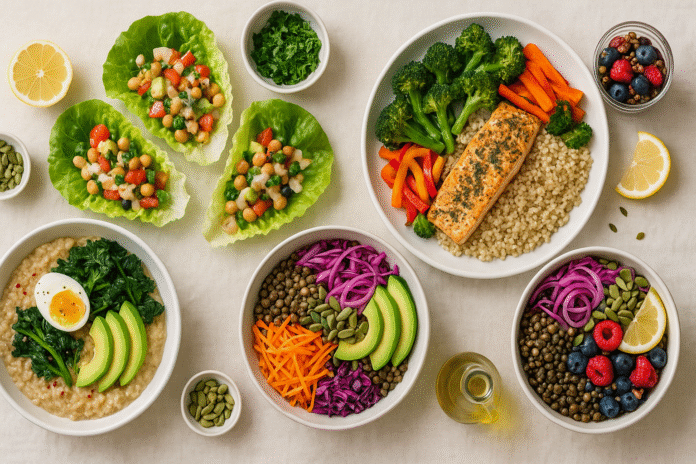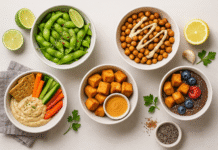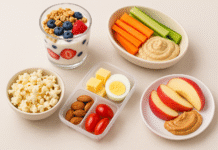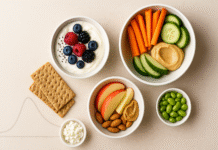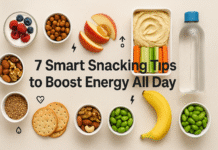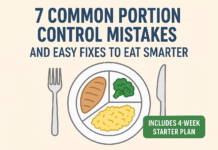If you’re craving a calmer, more intentional relationship with food, a mindful eating meal plan can be your daily compass. Mindful eating simply means paying attention—on purpose—to what, why, and how you eat. The five recipes below are built to slow you down, engage your senses, and deliver naturally satisfying nutrition (think fiber, protein, and healthy fats) without fussy rules. Whether you’re meal-prepping for the week or cooking for one, these dishes help you listen to hunger/fullness cues, savor flavors, and feel comfortably nourished.
Disclaimer: This article is educational and not a substitute for personalized medical or nutrition advice. If you have a health condition, allergies, or specific dietary needs, consult a qualified professional.
Key takeaways
- Mindful eating is about attention, not restriction—use your senses and internal cues to guide portions.
- Balanced plates (protein + fiber + healthy fats) help satisfaction and steadier energy.
- Five versatile recipes anchor a weekly plan: breakfast, lunch, dinner, bowl, and snack/dessert.
- Built-in practice prompts (pace, pause points, satiety check-ins) make mindfulness practical.
- A 4-week roadmap and troubleshooting guide help you integrate habits without overwhelm.
1) Warm Savory Oat Bowl with Greens, Soft-Boiled Egg & Avocado
What it is & why it belongs in a mindful eating meal plan
This is not your average oatmeal. Steel-cut or rolled oats go savory with olive oil, garlic-sautéed greens, a soft-boiled egg, and creamy avocado. It’s warm, hearty, and textured—perfect for engaging your senses and encouraging slower bites. You’ll get fiber from oats and greens, protein from the egg, and satisfying fats from avocado and olive oil.
Requirements & low-cost alternatives
- Equipment: saucepan, skillet, knife, cutting board, spoon. Optional: small strainer, timer.
- Ingredients (1 serving):
- ½ cup rolled oats (or ⅓ cup steel-cut)
- 1 cup low-sodium broth or water (plus more as needed)
- 1 tsp olive oil
- 1 small garlic clove, minced (or ¼ tsp garlic powder)
- 1–2 cups chopped greens (spinach, kale, or chard)
- 1 egg (or ½ cup white beans for a plant-based swap)
- ¼ avocado, sliced
- Pinch of salt and black pepper, squeeze of lemon, red pepper flakes (optional)
- Budget swaps: use water instead of broth, frozen greens instead of fresh, canned beans instead of eggs (drain and rinse).
Step-by-step instructions
- Cook oats. Combine oats with liquid; simmer until creamy (about 5–7 minutes for rolled, 20–30 for steel-cut). Stir occasionally.
- Sauté greens. Warm olive oil in a skillet on medium. Add garlic for 30 seconds, then greens with a pinch of salt; sauté 2–3 minutes until wilted.
- Soft-boil egg. Simmer water; gently lower egg and cook 6½ minutes for jammy yolk. Transfer to cold water, peel.
- Assemble. Spoon oats into a bowl. Top with greens, halved egg, avocado, pepper, lemon, and red pepper flakes.
- Mindful pause points. Smell the steam, notice color contrast, and take your first bite without phone or TV.
Beginner modifications & progressions
- Simplify: use instant oats; top with pre-washed baby spinach (stir into hot oats to wilt).
- Progress: add herbs (parsley, scallions), swap egg for smoked salmon or tofu, or sprinkle toasted seeds for crunch.
Recommended frequency & metrics
- Frequency: 2–3 breakfasts per week.
- Metrics to watch: eating time (aim 10–15 minutes), satiety rating 20 minutes after finishing (1–10 scale), afternoon energy steadiness.
Safety, caveats & common mistakes
- Food safety: cook eggs thoroughly if you’re pregnant or immunocompromised.
- Common mistakes: skipping salt completely can make this bland; instead, use a pinch and lemon to brighten. If it’s too thick, whisk in hot water.
Mini-plan example (2–3 steps)
- Sunday: batch-cook 3–4 portions of oats.
- Weekday mornings: reheat oats, wilt greens, top with an egg or beans.
- Mindfulness cue: put the spoon down between bites and exhale once before the next.
2) Mediterranean Chickpea Salad Lettuce Cups with Lemon–Tahini
What it is & why it belongs in a mindful eating meal plan
A crunchy, creamy, colorful lunch you eat with your hands—perfect for slowing down. Protein-rich chickpeas pair with crisp cucumbers, tomatoes, olives, and a lemon–tahini drizzle. The textures cue you to chew thoroughly and notice fullness early.
Requirements & low-cost alternatives
- Equipment: bowl, knife, cutting board, spoon, small jar for dressing.
- Ingredients (2 servings):
- 1 can chickpeas, drained and rinsed
- 1 cup chopped cucumber
- 1 cup cherry tomatoes, halved
- ¼ cup red onion, finely diced (optional)
- ¼ cup chopped parsley or mint
- ¼ cup olives, sliced (or capers, 1–2 tbsp)
- 6–8 large lettuce leaves (romaine, butter, or iceberg)
- Dressing: 2 tbsp tahini, 2 tbsp lemon juice, 2–3 tbsp water (to thin), 1 tsp olive oil, ¼ tsp salt, black pepper, pinch cumin
- Budget swaps: use carrots instead of cucumbers; skip olives; replace tahini with yogurt or peanut butter.
Step-by-step instructions
- Make dressing. Shake tahini, lemon, water, oil, salt, pepper, cumin in a jar until smooth.
- Toss salad. Combine chickpeas, cucumber, tomatoes, onion, herbs, and olives in a bowl. Add half the dressing; toss.
- Build cups. Spoon salad into lettuce leaves. Drizzle with more dressing as desired.
- Mindful pause points. Notice the sound of crunching, the lemon aroma, and how your jaw slows as you chew.
Beginner modifications & progressions
- Simplify: use pre-chopped veg or a bagged Mediterranean mix; use store-bought hummus thinned with lemon as dressing.
- Progress: add grilled chicken or baked tofu, sprinkle pumpkin seeds, or wrap in whole-grain pitas.
Recommended frequency & metrics
- Frequency: 2–3 lunches per week.
- Metrics: chewing count (aim 8–12 chews per bite), fullness at 15 and 120 minutes post-meal, afternoon craving intensity.
Safety, caveats & common mistakes
- Food safety: keep dressing chilled; don’t let assembled cups sit at room temp >2 hours.
- Allergens: sesame (tahini). Swap if needed.
- Common mistakes: overdressing leads to sogginess; dress lightly and add more at the table.
Mini-plan example
- Sunday: chop vegetables; stir dressing; store separately.
- Weekdays: assemble fresh cups; eat screen-free for the first 5 minutes to set the tone.
3) Sheet-Pan Herbed Salmon with Quinoa & Roasted Vegetables
What it is & why it belongs in a mindful eating meal plan
A one-pan dinner with minimal cleanup, rich in protein and heart-friendly fats, plus roasted vegetables for fiber and flavor. The roasted edges, fragrant herbs, and warm quinoa invite slower, appreciative bites that extend mealtime without extra effort.
Requirements & low-cost alternatives
- Equipment: sheet pan, parchment (optional), pot for quinoa, knife, cutting board.
- Ingredients (2–3 servings):
- 2 small salmon fillets (or firm tofu blocks for plant-based)
- 2 cups mixed vegetables (broccoli florets, bell peppers, carrots, zucchini)
- 1 tbsp olive oil
- 1 tsp dried herbs (dill, oregano, or Italian blend)
- ½ tsp garlic powder, ¼ tsp salt, black pepper, lemon wedges
- ¾ cup dry quinoa, rinsed
- 1½ cups water or low-sodium broth
- Budget swaps: use frozen fish/veg; replace quinoa with brown rice or bulgur.
Step-by-step instructions
- Preheat oven to 400°F (205°C).
- Cook quinoa. Combine rinsed quinoa with water/broth; boil, then cover and simmer 15 minutes; rest 5 minutes.
- Roast vegetables. Toss veg with oil, herbs, garlic powder, salt, pepper; spread on sheet pan; roast 12 minutes.
- Add salmon. Move veg aside; place salmon skin-side down. Season, add lemon. Roast 10–12 minutes more, until fish flakes.
- Assemble bowls. Spoon quinoa, top with salmon and veg; spritz lemon.
- Mindful pause points. Inhale the roasted aroma, then take a small first bite; notice warmth, texture, and flavor before swallowing.
Beginner modifications & progressions
- Simplify: roast everything longer at 375°F (190°C) if you’re nervous about timing.
- Progress: add a yogurt-dill sauce, roast cherry tomatoes for sweetness, or finish with capers for briny contrast.
Recommended frequency & metrics
- Frequency: 1–2 dinners per week.
- Metrics: dinner duration (aim 15–25 minutes), next-morning energy, late-night snacking frequency.
Safety, caveats & common mistakes
- Food safety: fish is done when it flakes easily; a safe internal temperature is 145°F (63°C).
- Allergens: fish; use tofu or tempeh if needed.
- Common mistakes: cramming the pan (veg steam instead of roast). Leave space for browning.
Mini-plan example
- Sunday night: roast double vegetables; cook extra quinoa.
- Midweek: reheat quinoa + veg, roast fresh salmon (10 minutes) for a fast dinner.
4) Rainbow Lentil & Brown Rice Buddha Bowl with Quick-Pickled Onions
What it is & why it belongs in a mindful eating meal plan
This bowl layers warm brown rice, spiced lentils, crunchy slaw, creamy avocado, and a tangy 10-minute pickle. The color spectrum nudges you to slow down—more colors = more flavors and textures to explore. Lentils and rice form a satisfying base with steady, balanced energy.
Requirements & low-cost alternatives
- Equipment: saucepan(s), skillet, small jar for pickles, knife, cutting board.
- Ingredients (2–3 servings):
- 1 cup dry brown rice
- 1 cup dry green or brown lentils, rinsed
- 1 tsp olive oil
- 1 tsp curry powder or smoked paprika + cumin
- ½ tsp salt, black pepper
- 2 cups shredded cabbage/carrot slaw
- ½ avocado, sliced
- ¼ cup roasted seeds (pumpkin or sunflower)
- Quick-pickled onion: ½ red onion (thinly sliced), ¼ cup vinegar, ¼ cup hot water, ½ tsp sugar, ¼ tsp salt
- Lemon wedges, fresh herbs for finishing
- Budget swaps: use canned lentils (rinsed), pre-cooked rice packets, or skip avocado.
Step-by-step instructions
- Cook rice according to package directions.
- Cook lentils. Simmer in water until tender (20–25 minutes). Drain.
- Season lentils. Warm oil in skillet; add spices and lentils; season with salt/pepper.
- Quick pickle. Stir vinegar, hot water, sugar, salt; add onion. Let stand 10 minutes.
- Assemble bowls. Rice → lentils → slaw → avocado → seeds → pickled onion → herbs and lemon.
- Mindful pause points. Hold the warm bowl, feel the heat in your hands, and identify three distinct flavors as you eat.
Beginner modifications & progressions
- Simplify: use a bagged slaw and leftover grains; skip pickles and add a squeeze of lemon.
- Progress: add roasted sweet potatoes or broccoli; drizzle tahini-lemon or plain yogurt.
Recommended frequency & metrics
- Frequency: 1–2 lunches or dinners per week.
- Metrics: pre-meal hunger rating vs. post-meal fullness; notice whether the bowl keeps you satisfied 3–4 hours.
Safety, caveats & common mistakes
- Food safety: refrigerate components separately; assemble just before eating.
- Common mistakes: under-seasoning the lentils; bloom spices in oil for fuller flavor.
Mini-plan example
- Batch day: cook a pot of lentils and rice; quick-pickle two onions (lasts ~1 week in fridge).
- Weekdays: mix-and-match bowls with any leftover veg.
5) Cacao–Chia Yogurt Parfait with Berries & Toasted Nuts
What it is & why it belongs in a mindful eating meal plan
A not-too-sweet snack or dessert with creamy yogurt, cocoa’s deep aroma, fiber-rich chia, bright berries, and crunchy nuts. It’s a sensory trifecta—scent, texture, and color—that helps you slow down and feel satisfied with a modest portion.
Requirements & low-cost alternatives
- Equipment: jar or bowl, spoon, small skillet for toasting nuts.
- Ingredients (1–2 servings):
- ¾ cup plain yogurt (dairy or fortified plant-based)
- 1 tbsp chia seeds
- 1–2 tsp unsweetened cocoa powder
- ½–1 tsp honey or maple syrup (optional)
- ½ cup berries (fresh or frozen, thawed)
- 2 tbsp chopped nuts (walnuts, almonds, or peanuts), lightly toasted
- Pinch cinnamon, vanilla extract (optional)
- Budget swaps: use frozen berries, skip nuts and add oats.
Step-by-step instructions
- Mix base. Stir yogurt with chia, cocoa, and sweetener. Let stand 5–10 minutes to thicken.
- Toast nuts. Warm nuts in a dry skillet 2–3 minutes until fragrant.
- Layer. Spoon yogurt mixture into a bowl, top with berries and nuts.
- Mindful pause points. Smell cocoa before first bite; note the contrast between creamy and crunchy.
Beginner modifications & progressions
- Simplify: skip toasting; use pre-roasted nuts or seeds.
- Progress: add orange zest, a few dark chocolate shavings, or a sprinkle of granola for variety.
Recommended frequency & metrics
- Frequency: 3–5 snacks per week (as desired).
- Metrics: observe whether this snack curbs late-night cravings; check energy steadiness between meals.
Safety, caveats & common mistakes
- Allergens: dairy and nuts; choose alternatives as needed.
- Common mistakes: using overly sweetened yogurt; start with plain and sweeten lightly to taste.
Mini-plan example
- Prep 3 jars on Sunday night; store covered in the fridge.
- Weeknights: enjoy slowly after dinner, ideally away from screens.
Quick-Start Checklist (Practical & Fast)
- Set a cue: choose a “mindfulness minute” before each meal—one deep breath, three aroma inhales, or one gratitude thought.
- Plate balance: aim for half vegetables/fruit, a quarter protein, a quarter whole grains or starchy veg, plus a little healthy fat.
- Environment reset: sit down, clear your space, and put your phone out of reach for the first 5 minutes.
- Portion with your eyes: start smaller than usual; you can always add more after a 5-minute check-in.
- Pace: bite, put utensils down, chew fully, sip water or tea, then continue.
- Track simply: after each meal, jot a 1–10 hunger → fullness rating and one sensory note (“peppery, crunchy”).
- Prep anchors: cook grains and beans once, roast a tray of veg, make 1 dressing and 1 sauce.
Troubleshooting & Common Pitfalls
“I still inhale my meals.”
Build stops into the recipe: garnish halfway through, or switch hands for 3 bites. Start with a 10-minute timer just to remind you to slow down (not to limit eating).
“I’m hungry again an hour later.”
Check plate balance: did you include protein, fiber, and fat? Add an egg, beans, or tofu (protein), a handful of veggies or oats (fiber), and olive oil, avocado, nuts, or seeds (fat).
“I get bored of the same flavors.”
Rotate herbs/spices weekly (dill vs. cumin vs. za’atar). Keep a small “flavor shelf”: lemon, vinegar, chili flakes, fresh herbs, a jar of olives, and mustard.
“Meal prep feels overwhelming.”
Think components, not full meals. Batch-cook grains + beans, roast veg, and mix one dressing. Assemble different meals from shared parts.
“I can’t tell if I’m full.”
Pause at the 50% mark. Ask: If I were eating my favorite dessert next, how hungry would I be for it? If the answer is “not much,” you’re likely at comfortable fullness.
“Cravings hit late at night.”
Have a planned, mindful snack (chia parfait, fruit + nuts, or warm milk/tea). Slow the pace: small bowl, spoon down, lights low.
“Dining out derails me.”
Set an intention: connect with people and notice flavors. Share an entree, order extra veg, and keep the first 5 minutes screen-free to anchor mindful pace.
“Family isn’t on board.”
Serve familiar bases (rice, pasta, tortillas) with optional mindful add-ons (slaw, herbs, seeds). Invite them to pick a topping to personalize.
How to Measure Progress (Without Obsessing)
- Meal duration: Add 3–5 minutes to your average mealtime.
- Satiety stability: Track how many hours you feel satisfied after meals; aim for 3–4 hours after lunch and dinner.
- Craving intensity: Use a 1–10 scale at night; trend down over weeks, not days.
- Energy consistency: Note afternoon slumps; the goal is fewer and milder dips.
- Mindful moments: Count intentional pauses per meal (goal: 3–5).
- Cooking confidence: Each week, add one new skill (e.g., pickling onions, cooking quinoa, toasting nuts).
A Simple 4-Week Starter Plan
Week 1 — Set the table
- Make Savory Oats twice, Chickpea Lettuce Cups once, Cacao–Chia Parfait three times.
- Practice the first 5 minutes screen-free and a pre-meal breath.
- Metrics: hunger/fullness rating before and 20 minutes after each meal.
Week 2 — Build balance
- Add Sheet-Pan Salmon once and Buddha Bowl once.
- Batch-cook grains and beans; make one dressing and one sauce.
- Metrics: hours of satiety after lunch; note any afternoon slump.
Week 3 — Expand flavor
- Rotate herbs and acids (lemon, lime, vinegar).
- Try one new vegetable and one new whole grain.
- Metrics: number of mindful pauses per meal; craving intensity at night.
Week 4 — Personalize
- Swap proteins (tofu/tempeh/eggs/legumes/fish) and add one family-style meal.
- Metrics: overall energy rating (morning/afternoon/evening), plus meal duration.
At the end of Week 4, review: Which recipes felt most satisfying? Which cues helped you slow down? Keep those and rotate new flavors for variety.
Safety, Caveats & Smart Swaps
- Allergies & intolerances: swap dairy yogurt for fortified non-dairy, nuts for seeds, fish for tofu/tempeh, and wheat-based sides for gluten-free grains as needed.
- Sodium awareness: taste before salting; rely on lemon, herbs, spices, and aromatics for flavor.
- Food safety basics: chill leftovers within 2 hours; reheat to steaming; store dressings separately to avoid soggy salads.
- Special conditions: pregnancy, chronic illness, or medication may require tailored guidance—work with a professional for adjustments.
Frequently Asked Questions
1) Can I follow this mindful eating meal plan if I’m trying to lose weight?
Yes, if you focus on internal cues and balanced plates rather than strict rules. Prioritize protein, fiber, and healthy fats so meals are satisfying, and use the satiety and pacing metrics to guide portions.
2) What if I don’t like cooking?
Lean on component prep: canned beans, pre-washed greens, pre-cooked grains, rotisserie chicken or baked tofu, jarred sauces. Assembly can take 5–10 minutes and still support mindful eating.
3) How long should a mindful meal take?
There’s no universal number, but many people find 10–25 minutes is a realistic range for everyday meals. Use a gentle timer as a reminder to pause—not as pressure.
4) Is it okay to snack?
Absolutely. Snacks can be mindful if you pause before you start, choose texture-rich foods (fruit + nuts, yogurt + chia), and stop when comfortably satisfied.
5) How do I handle social events?
Set an intention to connect and savor. Eat a balanced mini-meal earlier if the timing is late, take smaller first portions, and pause mid-plate to check in with fullness.
6) Do I need to count calories or track macros?
Not required for mindful eating. If data helps you, track qualitative metrics (meal duration, satiety, cravings, energy), which align better with internal cues.
7) Can I make the recipes vegan or gluten-free?
Yes. Swap salmon for tofu/tempeh, eggs for beans, and use gluten-free grains like quinoa, brown rice, or buckwheat. Tahini, olive oil, herbs, and spices keep flavor robust.
8) What if I’m still hungry after a meal?
Wait 10 minutes, drink water or tea, and check in. If you’re still physically hungry, add a small portion of protein or fiber (e.g., more lentils, yogurt, or vegetables).
9) How do I reduce grocery costs with this plan?
Buy frozen produce, choose store-brand staples, cook dried beans, and plan around sales (e.g., a big tray of roasted veg becomes sides, bowls, and wraps). Spices are a small upfront cost with huge flavor payoff.
10) Can mindful eating help with cravings for sweets?
Often yes, because it encourages you to notice the craving, eat slowly, and choose options that satisfy both taste and texture. The Cacao–Chia Parfait is designed for this role—rich flavor, moderate portion, and mindful pace.
11) How much water should I drink with meals?
There’s no single amount that fits everyone. Sip as needed to enhance enjoyment and digestion; many people do well with a glass of water or unsweetened tea alongside meals.
12) How soon might I notice benefits?
Some people feel calmer after just a few mindful meals. Appetite steadiness and energy patterns often improve over 2–4 weeks as you practice consistently.
Conclusion
Mindful eating is less about rules and more about relationship—between you, your food, and the moment you’re in. These five recipes make that relationship practical: they’re balanced, flexible, and full of built-in cues that help you slow down, savor, and stop at comfortable fullness. Start with one recipe this week, track a couple of simple metrics, and let small, satisfying wins compound.
Copy-ready CTA: Try one recipe tonight—set your phone aside for the first five minutes, take a breath, and really taste your food.
References
- Mindful Eating — The Nutrition Source, Harvard T.H. Chan School of Public Health. https://www.hsph.harvard.edu/nutritionsource/mindful-eating/
- Fiber — The Nutrition Source, Harvard T.H. Chan School of Public Health. https://www.hsph.harvard.edu/nutritionsource/carbohydrates/fiber/
- Protein — The Nutrition Source, Harvard T.H. Chan School of Public Health. https://www.hsph.harvard.edu/nutritionsource/what-should-you-eat/protein/
- Whole Grains — The Nutrition Source, Harvard T.H. Chan School of Public Health. https://www.hsph.harvard.edu/nutritionsource/what-should-you-eat/whole-grains/
- Healthy Drinks — The Nutrition Source, Harvard T.H. Chan School of Public Health. https://www.hsph.harvard.edu/nutritionsource/healthy-drinks/
- Oats — The Nutrition Source, Harvard T.H. Chan School of Public Health. https://www.hsph.harvard.edu/nutritionsource/food-features/oats/
- Quinoa — The Nutrition Source, Harvard T.H. Chan School of Public Health. https://www.hsph.harvard.edu/nutritionsource/food-features/quinoa/
- Fish and Omega-3 Fatty Acids — American Heart Association. https://www.heart.org/en/healthy-living/healthy-eating/eat-smart/fats/fish-and-omega-3-fatty-acids
- Safe Minimum Internal Temperature Chart — FoodSafety.gov, U.S. Department of Health & Human Services. https://www.foodsafety.gov/food-safety-charts/safe-minimum-cooking-temperature
- Dietary Guidelines for Americans, 2020–2025 (Sodium Guidance) — U.S. Department of Agriculture and U.S. Department of Health & Human Services. https://www.dietaryguidelines.gov/resources/2020-2025-dietary-guidelines-online-materials
- The Benefits of Probiotics — Harvard Health Publishing. https://www.health.harvard.edu/staying-healthy/the-benefits-of-probiotics




























